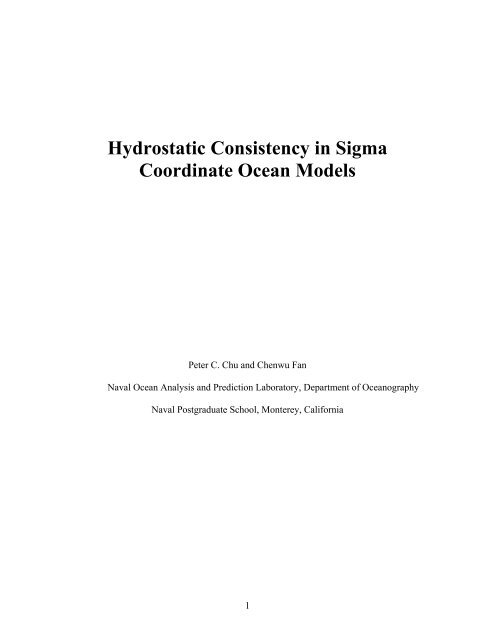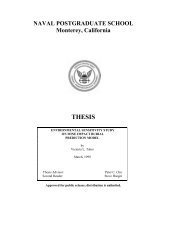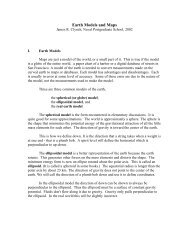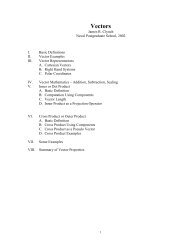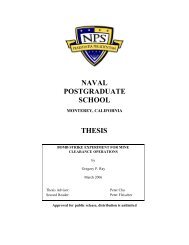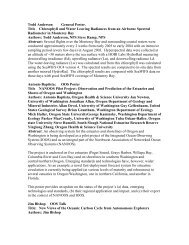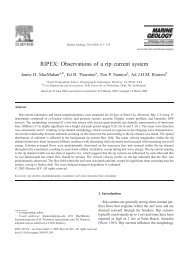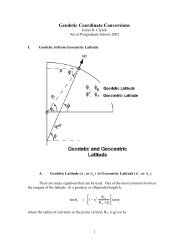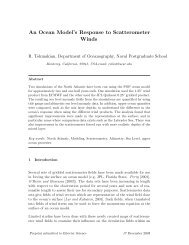Hydrostatic Consistency in Sigma Coordinate Ocean Models - NPS ...
Hydrostatic Consistency in Sigma Coordinate Ocean Models - NPS ...
Hydrostatic Consistency in Sigma Coordinate Ocean Models - NPS ...
You also want an ePaper? Increase the reach of your titles
YUMPU automatically turns print PDFs into web optimized ePapers that Google loves.
<strong>Hydrostatic</strong> <strong>Consistency</strong> <strong>in</strong> <strong>Sigma</strong><br />
Coord<strong>in</strong>ate <strong>Ocean</strong> <strong>Models</strong><br />
Peter C. Chu and Chenwu Fan<br />
Naval <strong>Ocean</strong> Analysis and Prediction Laboratory, Department of <strong>Ocean</strong>ography<br />
Naval Postgraduate School, Monterey, California<br />
1
Abstract<br />
Truncation error and hydrostatic <strong>in</strong>consistency at steep topography are two<br />
concerns <strong>in</strong> sigma coord<strong>in</strong>ate ocean models due to the horizontal pressure gradient be<strong>in</strong>g<br />
difference of two large terms. A consensus is reached <strong>in</strong> the ocean model<strong>in</strong>g community<br />
on the first concern (truncation error), but not on the second concern (hydrostatic<br />
<strong>in</strong>consistency). S<strong>in</strong>ce the <strong>in</strong>tegration of the pressure gradient over a f<strong>in</strong>ite volume equals<br />
the <strong>in</strong>tegration of the pressure over the surface of that volume (always dynamically<br />
consistent), dynamical analysis on f<strong>in</strong>ite volumes is used to determ<strong>in</strong>e the hydrostatic<br />
consistency of a sigma coord<strong>in</strong>ate ocean model. A discrete, hydrostatically consistent<br />
scheme is obta<strong>in</strong>ed for the sigma coord<strong>in</strong>ate ocean models. Comparison between f<strong>in</strong>itevolume<br />
and f<strong>in</strong>ite-difference approaches leads to the conclusion that a Bouss<strong>in</strong>esq,<br />
hydrostatic, sigma coord<strong>in</strong>ate ocean model with second-order staggered scheme is always<br />
hydrostatically consistent. Guidance for improv<strong>in</strong>g numerical accuracy is also provided.<br />
2
1. Introduction<br />
In regional oceanic (or atmospheric) prediction models the effects of bottom<br />
topography must be taken <strong>in</strong>to account and a cont<strong>in</strong>uous topography is implied <strong>in</strong> terra<strong>in</strong>follow<strong>in</strong>g<br />
sigma coord<strong>in</strong>ates. The water column is divided <strong>in</strong>to the same number of grid<br />
cells <strong>in</strong>dependence of depth. We restrict attention to two dimensions. Let (x, z) denote<br />
Cartesian coord<strong>in</strong>ates and (x*,<br />
σ ) be the sigma coord<strong>in</strong>ates. The conventional<br />
relationship between z- and sigma-coord<strong>in</strong>ates is given by<br />
x = x*, z = σ H( x*)<br />
, (1)<br />
where z and σ <strong>in</strong>crease vertically upward such that z = σ = 0 at the surface and σ =−1,<br />
z = -H at the bottom. The horizontal pressure gradient can be computed by<br />
∂p ∂p*<br />
σ ∂H<br />
∂p *<br />
= −<br />
. (2)<br />
∂x ∂x* H ∂x*<br />
∂σ<br />
The horizontal pressure gradient becomes difference between two large terms, which may<br />
cause two problems: (1) truncation error at steep topography [e.g., Gary, 1973; Haney,<br />
1991; Mellor et al., 1994, 1998; McCalp<strong>in</strong>, 1994; Chu and Fan, 1997, 1998; Song, 1998],<br />
and (2) hydrostatic <strong>in</strong>consistency [e.g., Mes<strong>in</strong>ger, 1984; Haney, 1991].<br />
A consensus is reached <strong>in</strong> the ocean model<strong>in</strong>g community that the first problem<br />
does exist and several methods have been suggested to reduce the truncation errors to<br />
acceptable levels: (1) smooth<strong>in</strong>g topography [e.g., Chu and Fan, 2001], (2) subtract<strong>in</strong>g a<br />
mean vertical density profile before calculat<strong>in</strong>g the gradient [Gary, 1973], (3) br<strong>in</strong>g<strong>in</strong>g<br />
certa<strong>in</strong> symmetries of the cont<strong>in</strong>uous forms <strong>in</strong>to the discrete level to ensure cancellations<br />
of these terms such as the density Jacobian scheme [e.g., Mellor et al. 1998; Song, 1998;<br />
3
Song and Wright, 1998], (4) <strong>in</strong>creas<strong>in</strong>g numerical accuracy [e.g., McCalp<strong>in</strong>, 1994; Chu<br />
and Fan, 1997, 1998, 1999, 2000, 2001], (5) chang<strong>in</strong>g the grid from a sigma grid to a z-<br />
level grid before calculat<strong>in</strong>g the horizontal pressure gradient [e.g., Stell<strong>in</strong>g and van<br />
Kester, 1994]. Kliem and Pietrzak [1999] claimed that the z-level based pressure gradient<br />
calculation is the most simple and effective means to reduce the pressure gradient errors.<br />
However, Ezer et al. [2002] found that the density Jacobian scheme is more preferable.<br />
No consensus is reached on whether the second problem exists. Based on the<br />
earlier work for atmospheric models [e.g., Messiger, 1982], Haney [1991] po<strong>in</strong>ted out<br />
that the vertical discretization <strong>in</strong> sigma coord<strong>in</strong>ate ocean models ( δσ ) should satisfy the<br />
hydrostatic consistency condition,<br />
σδ H x<br />
r ≡ < 1<br />
(3)<br />
H δσ<br />
to keep the computational stability. Here r is the hydrostatic consistency parameter;<br />
δ H x<br />
is the horizontal change <strong>in</strong> depth of adjacent grid cells; and<br />
δσ is the vertical cell<br />
size associated with a sigma grid, δxδσ . However, Mellor et al. [1994] thought that r is<br />
just another measure of the numerical accuracy after conduct<strong>in</strong>g a numerical simulation<br />
for the North Atlantic <strong>Ocean</strong> us<strong>in</strong>g the Pr<strong>in</strong>ceton <strong>Ocean</strong> Model with r = 3. More<br />
numerical experiments with various schemes for the seamount test case [e.g., Ezer et al.,<br />
2002] were conducted to show convergent solutions with r = 14.2. These experiments<br />
show that the condition (3) is not the ultimate condition for numerical calculation, but the<br />
<strong>in</strong>dication of the first (second) term <strong>in</strong> the righthand-side of (2) is larger if r < 1 (r > 1).<br />
Does the hydrostatic <strong>in</strong>consistency regard<strong>in</strong>g to the computational <strong>in</strong>stability<br />
really exist? We use the f<strong>in</strong>ite volume <strong>in</strong>tegration approach [L<strong>in</strong>, 1997] to reexam<strong>in</strong>e the<br />
concept of hydrostatic consistency (regard<strong>in</strong>g the stability) <strong>in</strong> this paper. A fully,<br />
4
hydrostatically consistent (i.e., hydrostatically stable) grid scheme is developed for sigma<br />
coord<strong>in</strong>ate ocean models. This scheme provides a criterion for the identification of<br />
hydrostatic consistency for various f<strong>in</strong>ite difference schemes. The outl<strong>in</strong>e of this part is as<br />
follows: Description of the hydrostatic consistency is given <strong>in</strong> section 2. A<br />
hydrostatically consistent staggered scheme for horizontal pressure gradient is given <strong>in</strong><br />
Section 3. Evidence of second-order staggered sigma ocean model is always<br />
hydrostatically consistent is given <strong>in</strong> Sections 4 and 5. In section 6, the conclusions are<br />
presented.<br />
2. <strong>Hydrostatic</strong> <strong>Consistency</strong><br />
Let the flow field change <strong>in</strong> x– z plane only (Fig. 1). A f<strong>in</strong>ite volume (trapezoidal<br />
cyl<strong>in</strong>der) is considered with the length of L y (<strong>in</strong> the y-direction) and the cross-section<br />
represented by the shaded region (trapezoid) <strong>in</strong> Figure 1. The resultant pressure force (F)<br />
act<strong>in</strong>g on the f<strong>in</strong>ite volume is computed as follows:<br />
∫<br />
F= L p n ds<br />
(4)<br />
y<br />
C<br />
where p is the pressure, C represents the four boundaries, n denotes the normal unit<br />
vector po<strong>in</strong>t<strong>in</strong>g <strong>in</strong>ward, and ds is an element of the boundary. The contour <strong>in</strong>tegral is<br />
taken counter-clockwise along the peripheral of the volume element. The pressure force<br />
exerts on boundaries of the f<strong>in</strong>ite-volume with p w , p e , p u , and p l on the west, east, upper,<br />
and lower sides. The horizontal (F x ) and vertical (F z ) components of the resultant<br />
pressure force are computed by<br />
2 3 4 1<br />
Fx L ⎛<br />
⎞<br />
=−<br />
y⎜∫ pdz<br />
l<br />
+ ∫ pedz+ ∫ pudz+<br />
∫ pwdz⎟, (5)<br />
⎝ 1 2 3 4 ⎠<br />
5
2 4<br />
Fz L ⎛<br />
⎞<br />
=<br />
y⎜∫ pdx<br />
l<br />
+ ∫ pudx⎟, (6)<br />
⎝ 1 3 ⎠<br />
where po<strong>in</strong>ts 1, 2, 3, and 4 are the four vertices of the f<strong>in</strong>ite volume. For hydrostatic<br />
balanced models, the follow<strong>in</strong>g condition must hold<br />
Fz<br />
= g∆m<br />
, (7)<br />
where g is the gravitational acceleration,<br />
∆m<br />
is the mass of the f<strong>in</strong>ite volume. Equation<br />
(7) states that the vertical component of the resultant pressure force act<strong>in</strong>g on the f<strong>in</strong>ite<br />
volume exactly balances the total weight of the f<strong>in</strong>ite volume.<br />
For a Bouss<strong>in</strong>esq, hydrostatic ocean model, the pressure field is given by<br />
0<br />
p = p + ρ0 gη+ g∫ ρ( x, z', t)<br />
dz ', (8)<br />
atm<br />
z<br />
where<br />
patm<br />
is the atmospheric pressure at the ocean surface, ρ 0<br />
is the characteristic<br />
density, and η is the surface elevation. Substitution of (8) <strong>in</strong>to (6) leads to<br />
2 0 4 0<br />
⎛<br />
⎞<br />
Fz<br />
= gLy⎜∫∫ρ( x, z ', t) dz ' dx + ∫∫ρ( x, z ', t) dz ' dx ⎟<br />
⎝ 1 z<br />
3 z<br />
⎠<br />
∫∫<br />
= gL ρ( x, z ', t) dz ' dx = g∆m,<br />
y<br />
∆S<br />
(9)<br />
where<br />
∆S is the area of the trapezoid (Fig. 1) computed by<br />
∆ S = ( xi+ 1<br />
−xi) ⋅ ( zi, k<br />
+ zi+ 1, k<br />
−zi, k+<br />
1<br />
− zi+<br />
1, k+ 1)<br />
, zik ,<br />
= Hi⋅σ<br />
k. (10)<br />
Eq.(9) <strong>in</strong>dicates that the f<strong>in</strong>ite-volume discretization guarantees the hydrostatic balance <strong>in</strong><br />
Bouss<strong>in</strong>esq, hydrostatic ocean models. Us<strong>in</strong>g (5) the horizontal pressure gradient is<br />
computed by<br />
6
2 3 4 1<br />
∂p<br />
F 1 ⎛<br />
⎞<br />
≡<br />
x = − ⎜ pldz + pedz + pudz + pwdz<br />
⎟<br />
∂x Ly∆S ∆S<br />
⎝ 1 2 3 4 ⎠<br />
∫ ∫ ∫ ∫ . (11)<br />
If the horizontal pressure gradient is represented by (11), the model is conserved and<br />
hydrostatic <strong>in</strong>consistency does not exist. Thus, deviation from the hydrostatic consistency<br />
becomes deviation of the horizontal pressure gradient computation from (11).<br />
3. Staggered Grid<br />
The staggered grid is represented <strong>in</strong> Figure 1 with the velocity at the center of the<br />
volume and pressure at the four vertices. Discretization of the horizontal pressure<br />
gradient with the f<strong>in</strong>ite-volume consideration (11) is given by<br />
∆ p 1 = ⎡ pl( zi+ 1, k+ 1 − zi, k+ 1) + pe( zi+ 1, k − zi+ 1, k+ 1<br />
) + pu( zi, k − zi+ 1, k) + pw(<br />
zi, k+<br />
1<br />
zi,<br />
k ⎤<br />
x S<br />
⎣<br />
− )<br />
∆ ∆<br />
⎦, (12)<br />
where pl, pe, pu,<br />
p<br />
w<br />
are the mean values of pressure at the four sides of the trapezoid.<br />
Equation (12) is the criterion for justify<strong>in</strong>g the hydrostatic consistency for ocean model<br />
with staggered grid. If the horizontal pressure gradient <strong>in</strong> sigma coord<strong>in</strong>ates (2) can be<br />
represented by (12), the model is hydrostatically consistent. Otherwise the model may be<br />
hydrostatically <strong>in</strong>consistent. For ocean models with C-grid, the two consecutive f<strong>in</strong>itevolumes<br />
are considered as one volume (Fig. 2). The hydrostatic consistency can be easily<br />
evaluated on these f<strong>in</strong>ite-volumes.<br />
4. Second-Order Accuracy<br />
For the second-order staggered grid, pl, pe, pu,<br />
p<br />
w, are taken as the arithmetic<br />
means of pressure at the two vertices,<br />
p<br />
w<br />
=<br />
p<br />
+ p<br />
ik , ik , + 1 ,<br />
2<br />
p<br />
e<br />
=<br />
p<br />
+ p<br />
i+ 1, k i+<br />
1, k + 1<br />
,<br />
2<br />
7
p<br />
l<br />
=<br />
p<br />
+ p<br />
ik , + 1 i+<br />
1, k+ 1<br />
ik , i+<br />
1, k<br />
u<br />
2<br />
p<br />
=<br />
p<br />
+ p<br />
2<br />
. (13)<br />
Substitution of (13) <strong>in</strong>to (12) leads to<br />
( pi+ 1, k+ 1<br />
− pi, k) ⋅( Hi+ 1σk − Hiσk+ 1) + ( pi+ 1, k<br />
− pi, k+ 1) ⋅( Hiσk −Hi+ 1σk+<br />
1)<br />
⎛∆p<br />
⎞<br />
⎜ ⎟ =<br />
⎝∆x⎠<br />
δx ⋅δσ<br />
⋅ H + H<br />
( )<br />
ik , i k i i+<br />
1<br />
, (14)<br />
where δ xi = xi+<br />
1<br />
−x<br />
i<br />
and δσ<br />
k<br />
= σ<br />
k<br />
−σ k + 1<br />
. Equation (14) is the discretization of the<br />
horizontal pressure gradient with the f<strong>in</strong>ite-volume consideration.<br />
5. F<strong>in</strong>ite Difference Scheme<br />
F<strong>in</strong>ite difference schemes are commonly used <strong>in</strong> sigma coord<strong>in</strong>ate ocean models.<br />
Us<strong>in</strong>g the central difference scheme, the horizontal pressure gradient (2) is discretized by<br />
⎛δ p⎞<br />
p + p − p − p σ + σ H −H<br />
p + p − p − p<br />
⎜ ⎟ = − ⋅ ⋅<br />
⎝δx ⎠<br />
2⋅ δx H + H δx<br />
2⋅δσ<br />
=<br />
i+ 1, k i+ 1, k+ 1 i, k i, k+ 1 k k+ 1 i+<br />
1 i i, k i+ 1, k i, k+ 1 i+<br />
1, k+<br />
1<br />
ik , i i i+<br />
1<br />
i k<br />
( pi+ 1, k+ 1<br />
− pi, k) ⋅( Hi+ 1σk − Hiσk+ 1) + ( pi+ 1, k<br />
− pi, k+ 1) ⋅( Hiσk −Hi+ 1σk+<br />
1)<br />
( )<br />
δx ⋅δσ<br />
⋅ H + H<br />
i k i i+<br />
1<br />
, (15)<br />
which is exactly the same as (14). This means that the sigma coord<strong>in</strong>ate ocean models<br />
with second-order staggered grid is always hydrostatically consistent. This confirms<br />
Mellor et al.’s [1994] claim that the hydrostatic consistency is irrelevant any way <strong>in</strong> the<br />
sigma coord<strong>in</strong>ate ocean models and that the hydrostatic consistency parameter r is just<br />
another measure of the numerical errors.<br />
6. Conclusions<br />
8
(1) Us<strong>in</strong>g the f<strong>in</strong>ite-volume <strong>in</strong>tegration approach, a hydrostatically consistent,<br />
discrete scheme [equation (12)] is obta<strong>in</strong>ed to compute horizontal pressure gradient. For<br />
the second-order accuracy, this scheme is exactly the same as the commonly used sigma<br />
coord<strong>in</strong>ate ocean models (staggered grids) with the second-order central difference<br />
scheme. This <strong>in</strong>dicates that the current sigma coord<strong>in</strong>ate ocean models with second order<br />
staggered scheme are always hydrostatically consistent.<br />
(2) Deviation of discretization schemes for comput<strong>in</strong>g the horizontal pressure<br />
gradient from equation (12) can be taken as a measure for hydrostatic <strong>in</strong>consistency. The<br />
larger the deviation, the larger the hydrostatic <strong>in</strong>consistency is.<br />
(3) Equation (12) provides the guidance for establish<strong>in</strong>g hydrostatically consistent<br />
schemes for horizontal pressure gradient. More accurate schemes should be developed on<br />
the base of accurate estimate of mean pressure at four sides of the f<strong>in</strong>ite-volume (i.e.,<br />
pl, pe, pu,<br />
p<br />
w).<br />
Acknowledgements<br />
This study was supported by the Office of Naval Research, the Naval <strong>Ocean</strong>ographic<br />
Office, and the Naval Postgraduate School.<br />
9
References<br />
Beckmann, A., and D. B. Haidvogel, Numerical simulation of flow around a tall isolated<br />
seamount. Part 1: Problem formulation and model accuracy. J. Phys. <strong>Ocean</strong>ogr., 23,<br />
1736-1753, 1993.<br />
Chu, P.C., and C.W. Fan, Sixth-order difference scheme for sigma coord<strong>in</strong>ate ocean<br />
models. J. Phys. <strong>Ocean</strong>ogr., 27, 2064-2071, 1997.<br />
Chu, P.C., and C.W. Fan, A three-po<strong>in</strong>t comb<strong>in</strong>ed compact difference scheme. J.<br />
Comput. Phys. 140, 370-399, 1998.<br />
Chu, P.C., and C. Fan, A three-po<strong>in</strong>t sixth-order nonuniform comb<strong>in</strong>ed compact<br />
difference scheme. J. Comput. Phys., 148, 663-674, 1999.<br />
Chu, P.C., and C.W. Fan, A staggered three-po<strong>in</strong>t comb<strong>in</strong>ed compact difference scheme.<br />
Math. Comput. Model<strong>in</strong>g, 32, 323-340, 2000.<br />
Chu, P.C., and C.W. Fan, An accuracy progressive sixth-order f<strong>in</strong>ite- difference scheme.<br />
J. Atmos. <strong>Ocean</strong>ic Technol., 18, 1245-1257, 2001.<br />
Ezer, T., H. Arango, A.F. Shchepetk<strong>in</strong>, Developments <strong>in</strong> terra<strong>in</strong>-follow<strong>in</strong>g ocean models:<br />
<strong>in</strong>tercomparisons of numerical aspects. <strong>Ocean</strong> Modell<strong>in</strong>g, 4, 249-267, 2002.<br />
10
Gary, J.M., Estimate of truncation error <strong>in</strong> transformed coord<strong>in</strong>ate primitive equation<br />
atmospheric models. J. Atmos. Sci., 30, 223-233, 1973.<br />
Haney, R.L., On the pressure gradient force over steep topography <strong>in</strong> sigma coord<strong>in</strong>ate<br />
ocean models. J. Phys. <strong>Ocean</strong>ogr., 21, 610-619, 1991.<br />
Kliem, N., and J.D. Pietrzak, On the pressure gradient error <strong>in</strong> sigma coord<strong>in</strong>ate ocean<br />
models: A comparison with a laboratory experiment. J. Geophys. Res., 104, 29781-<br />
29799, 1999.<br />
L<strong>in</strong>, S.-J., A f<strong>in</strong>ite volume <strong>in</strong>tegration method for comput<strong>in</strong>g pressure gradient force <strong>in</strong><br />
general vertical coord<strong>in</strong>ates. Q. J. R. Metoerol. Soc., 123, 1749-1762, 1997.<br />
McCalp<strong>in</strong>, J.D., A comparison of second-order and fourth-order pressure gradient<br />
algorithms <strong>in</strong> a sigma-coord<strong>in</strong>ate ocean model. Inter. J. Num. Methods <strong>in</strong> Fluids, 18, 361-<br />
383, 1994.<br />
Mellor, G.L., T. Ezer, and L.-Y. Oey, The pressure gradient conundrum of sigma<br />
coord<strong>in</strong>ate ocean models. J. Atmos. <strong>Ocean</strong>ic Technol., 11, 1126-1134, 1994.<br />
Mellor, G.L., L.-Y. Oey and T. Ezer, <strong>Sigma</strong> coord<strong>in</strong>ate pressure gradient errors and the<br />
seamount problem. J. Atmos. <strong>Ocean</strong>ic Technol., 15, 1122-1131, 1998.<br />
11
Song, Y.T., A general pressure gradient formulation for ocean models. Part 1: Scheme<br />
design and diagnostic analysis. Mon. Wea. Rev., 126, 3213-3230, 1998.<br />
Song, Y.T., and D.G. Wright, A general pressure gradient formulation for the ocean<br />
models. Part 2: Momentum and bottom torque consistency. Mon. Wea. Rev., 126, 3213-<br />
3230, 1998.<br />
Stell<strong>in</strong>g, G.S., and J.A.T.M. van Kester, On the approximation of horizontal gradients <strong>in</strong><br />
sigma coord<strong>in</strong>ates for bathymetry with steep bottom slope. Int. J. Numer. Methods<br />
Fluids, 18, 915-935, 1994.<br />
12
Figure 1. F<strong>in</strong>ite-volume discretization and staggered grid <strong>in</strong> terra<strong>in</strong>-follow<strong>in</strong>g<br />
coord<strong>in</strong>ates with two cells represent<strong>in</strong>g r > 1 and r < 1.<br />
Figure 2. Double f<strong>in</strong>ite-volumes for C-grid.<br />
13


